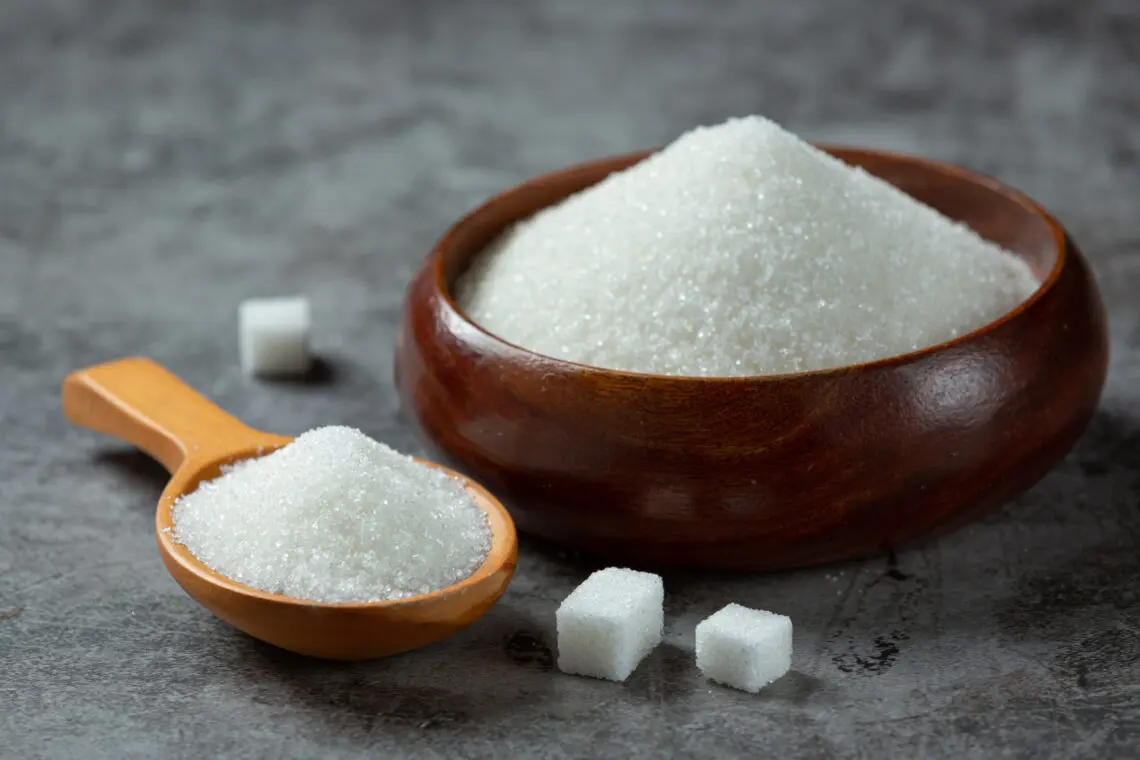The Hidden Sugar Bomb in Your Pet’s Bowl
Here’s the most important fact every pet parent should know:
The average bag of kibble contains 35-74% carbohydrates and starches.
Your pet’s digestive system converts ALL of this to sugar.
This means that most pet parents are unknowingly feeding their carnivorous companions a diet that’s 35-74% sugar—then wondering why their pets develop diabetes, obesity, and chronic diseases.
And this doesn’t even count the palatability spray applied after processing, which also contains sugars.
Why Pet Food Companies Hide Carbohydrate Content
Want to know something shocking? AAFCO (the pet food regulatory body) specifically discourages listing carbohydrate content on pet food labels.
Here’s the exact quote from their official publication:
“Carbohydrate guarantees are no longer considered as necessary or meaningful for purchaser information, therefore, their use is discouraged.” — AAFCO Annual Publication (2003, pg. 178)
Why would they discourage this information? Because if pet parents knew they were feeding their carnivorous pets a high-sugar diet, they might start asking uncomfortable questions about the appropriateness of grain-based pet foods.
The industry knows exactly what they’re hiding.
The Manufacturing Reality: Why Kibble MUST Be High-Carb
Here’s something the pet food industry doesn’t want you to understand: dry kibble cannot exist without massive amounts of starch.
The Kibble Manufacturing Process:
- 40-45% starches minimum required for kibble formation
- Starches act as “cement” to bind ingredients together
- Extrusion process requires starch to create those appealing shapes
- “Least cost mix” protocols use cheap carbs instead of expensive meat
Translation: Every bag of kibble is primarily a starch delivery system with meat flavoring, not a meat-based food with some starch added.
This isn’t a design flaw—it’s a manufacturing requirement.
What Carbohydrates Actually Do to Your Pet’s Body
The Blood Sugar Roller Coaster:
Step 1: The Spike
- High-carb kibble hits your pet’s system
- Blood sugar levels skyrocket rapidly
- Pancreas releases massive amounts of insulin
- Excess sugar gets converted to fat storage
Step 2: The Crash
- Blood sugar drops rapidly—often below starting levels
- Pet experiences mental lethargy, confusion, fatigue
- Hunger returns quickly despite recent meal
- Cycle repeats with next feeding
Step 3: The Long-Term Damage
- Repeated insulin spikes lead to insulin resistance
- Pancreas becomes exhausted from overwork
- Type 2 diabetes develops
- Chronic inflammation begins
Why This Is Devastating for Carnivores:
Natural carnivore diet: Nearly 0% carbohydrates Commercial kibble diet: 35-74% carbohydrates
This isn’t “moderate carbohydrates”—it’s metabolic abuse.
The Scientific Evidence: Carbs Aren’t Needed
Here are the facts that every major authority acknowledges:
✓ Dogs and cats have NO nutritional need for carbohydrates ✓ They evolved to use protein and fat as energy sources ✓ AAFCO nutrient profiles show NO minimum carbohydrate requirement ✓ The most efficient source of ALL required nutrients is animal tissue ✓ Natural prey diet contains almost no carbohydrates
The earliest scientific paper stating this was published in 1928. This isn’t new information—it’s ignored information.
Dr. David S. Kronfeld’s Research:
“Carbohydrates need not be supplied to adult dogs, even those working hard, as the liver is easily able to synthesize sufficient glucose from protein and fats.”
If working sled dogs—the ultimate canine athletes—don’t need dietary carbohydrates, why are we feeding sedentary house pets 35-74% carbs?
The Chronic Disease Connection
High-carbohydrate diets are directly linked to the epidemic of chronic diseases in modern pets:
Primary Effects:
- Obesity – excess carbs convert to fat storage
- Type 2 Diabetes – from insulin resistance
- Pancreatitis – from pancreatic overwork
- Thyroid disease – from metabolic disruption
Secondary Effects:
- Cancer – cancer cells thrive on glucose
- Arthritis – from chronic inflammation
- Digestive disorders – from inappropriate food processing
- Behavioral issues – from blood sugar instability
Think about this: These are the exact same diseases plaguing humans on high-carb, processed diets.
The Glycemic Load Problem
Glycemic Load measures both the amount of carbohydrates AND their impact on blood sugar. Commercial pet foods create a “perfect storm”:
High Quantity:
- 35-74% of total food is carbohydrates
- Multiple grain sources (corn, wheat, rice, etc.)
- Added sugars in palatability sprays
High Impact:
- Processed starches convert rapidly to sugar
- Simple carbs cause immediate blood sugar spikes
- No fiber to slow absorption (most pet food fiber is industrial waste)
The result: Massive glycemic loads that carnivorous digestive systems cannot handle appropriately.
The Energy Metabolism Truth
Pet food companies claim carbohydrates provide “economical energy,” but this ignores carnivore physiology:
How Carnivores Actually Create Energy:
Primary Energy Sources:
- Fat oxidation – clean-burning, stable energy
- Protein conversion – liver easily converts to glucose when needed
- Stored body fat – available for immediate use
Carbohydrate Role in Natural Diet:
- Nearly zero in prey animals
- Pre-digested plant matter in prey stomachs (minimal amounts)
- Seasonal fruits occasionally (small quantities)
The Athletic Dog Evidence:
Research on sled dogs and racing greyhounds shows:
- Most elite working dogs eat “homemade” raw diets (not commercial food)
- High-fat, high-protein diets provide superior endurance
- Excess carbohydrates actually inhibit fat-burning and may limit performance
If carbs were ideal energy for dogs, why don’t professional working dog handlers use high-carb kibble?
The Blood Sugar Regulation Disaster
Normal carnivore blood sugar regulation:
- Stable, low blood sugar from protein/fat metabolism
- Minimal insulin production needed
- Liver produces glucose as needed from protein
- No pancreatic stress
High-carb kibble blood sugar regulation:
- Wild blood sugar swings multiple times daily
- Massive insulin production required
- Pancreatic exhaustion over time
- Chronic metabolic stress
The Exhausted Pancreas:
“Over time, the dog will become insulin resistant (less sensitive to insulin), and to compensate, her pancreas may become exhausted as it works harder to produce more and more insulin.”
This is exactly how Type 2 diabetes develops in humans—and now in pets.
Simple vs. Complex Carbs: Both Problematic for Carnivores
Pet food marketing often emphasizes “complex carbs” as healthier, but this misses the point:
Simple Carbs (found in kibble):
- Rapid blood sugar spikes
- Quick conversion to fat
- Immediate insulin response
- Energy crashes
Complex Carbs (also found in kibble):
- Slower digestion but same endpoint – conversion to sugar
- May pass through undigested creating digestive stress
- Still inappropriate for carnivore physiology
- Often create voluminous stools (mistaken as “healthy”)
The fundamental issue isn’t the TYPE of carbohydrate—it’s that carnivores aren’t designed to eat significant amounts of ANY carbohydrates.
The “Economical Energy” Lie
Pet food companies justify high-carb content by claiming it provides “economical energy.” Here’s what this really means:
“Economical” for whom?
- Economical for manufacturers – grains are cheap filler
- Expensive for pet owners – vet bills for chronic diseases
- Devastating for pets – metabolic stress and shortened lifespans
Real economical energy for carnivores:
- Animal fat – species-appropriate, efficient, satisfying
- Quality protein – provides amino acids AND glucose when needed
- Natural satiety – pets eat appropriate amounts and stop
What About “Active” or “Working” Dogs?
The pet food industry markets high-carb foods for “active” dogs, but research shows the opposite:
Real Working Dog Nutrition:
- Mushers feed high-fat, raw meat diets to sled dogs
- Racing greyhounds perform best on meat-based diets
- Excess carbohydrates can actually inhibit endurance by blocking fat oxidation
The Mitochondria Factor:
Dog muscles have MORE mitochondria than human muscles and are designed to burn fat efficiently. Flooding this system with carbohydrates is like putting diesel fuel in a gasoline engine—it might run, but not optimally.
Even very lean athletes have enough stored body fat for back-to-back workouts. They don’t need dietary carbohydrates—they need the metabolic flexibility to access their stored energy efficiently.
The Bottom Line: The Numbers Don’t Lie
Natural carnivore diet: 0-5% carbohydrates Commercial kibble diet: 35-74% carbohydrates
That’s not “moderate carbohydrate intake”—that’s a completely different species’ diet.
We’re feeding carnivores like herbivores and wondering why they’re developing the same chronic diseases as humans on high-carb, processed diets.
The Solution Isn’t Better Carbs—It’s Species-Appropriate Nutrition:
- High-quality animal proteins for amino acids and glucose conversion
- Animal fats for stable, clean energy
- Organs and glands for concentrated nutrition
- Minimal to zero plant matter – only what would naturally be consumed
Your pet’s pancreas, liver, and entire metabolic system will thank you.
In our next article, we’ll explore the power of fermented foods—one of the few ways to make plant nutrients actually beneficial for carnivorous pets, and how ancient fermentation techniques can support modern pet health.
Key Takeaways:
✓ Most kibble is 35-74% carbohydrates (converts to sugar)
✓ AAFCO deliberately discourages listing carb content on labels
✓ Dogs and cats have ZERO nutritional requirement for carbohydrates
✓ High-carb diets cause blood sugar roller coaster and pancreatic stress
✓ Kibble manufacturing REQUIRES 40-45% starch minimum
✓ Elite working dogs eat high-fat, raw diets—not high-carb kibble
✓ Chronic diseases in pets mirror human diseases from high-carb diets
Carbohydrate-Related Health Issues:
- Obesity (gateway to all chronic diseases)
- Type 2 Diabetes from insulin resistance
- Pancreatitis from pancreatic overwork
- Cancer (cancer cells thrive on glucose)
- Arthritis from chronic inflammation
- Behavioral problems from blood sugar instability
- Digestive disorders from inappropriate food processing
The Manufacturing Reality:
- Starch acts as “cement” to hold kibble together
- 40-45% minimum starch required for extrusion process
- “Least cost mix” protocols prioritize cheap carbs over expensive meat
- Every bag of kibble is primarily a starch delivery system
Next in this series: “The Fermented Foods Revolution: Ancient Nutrition for Modern Pets”





